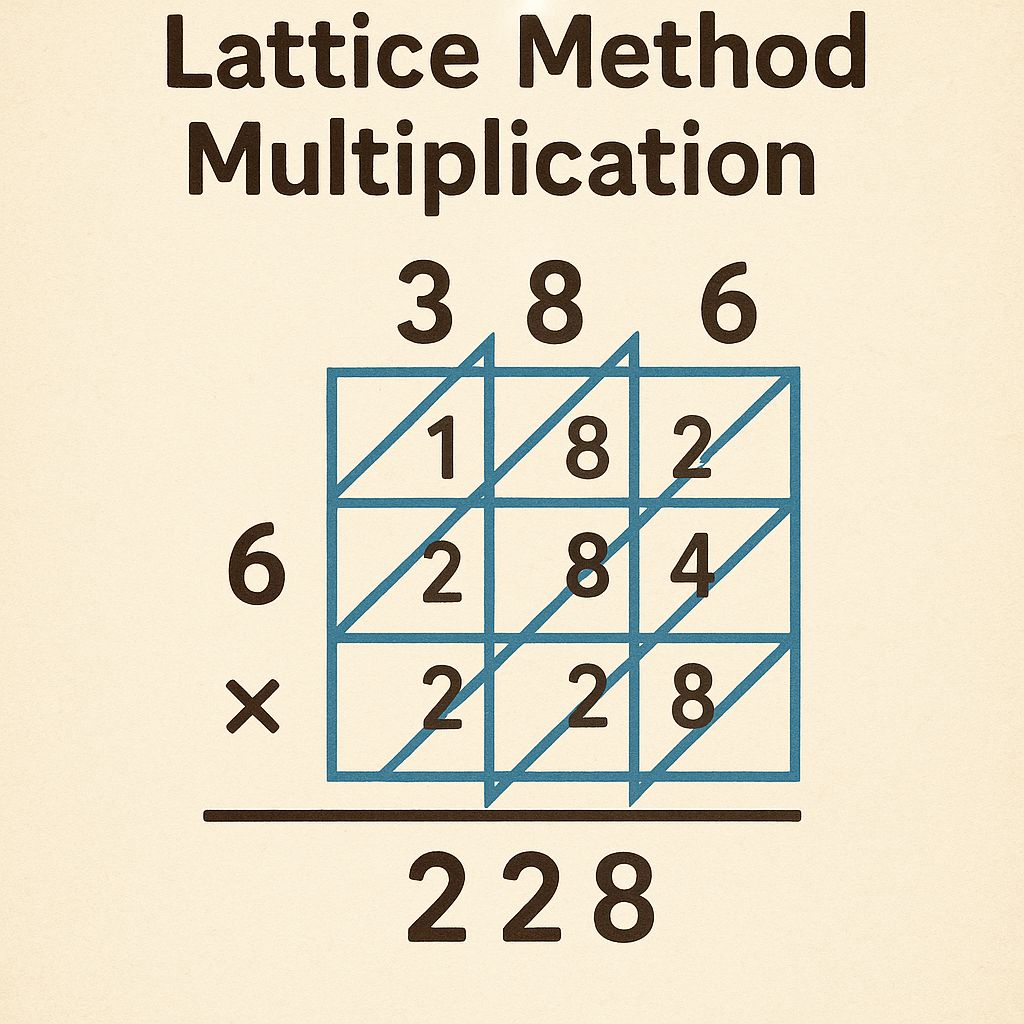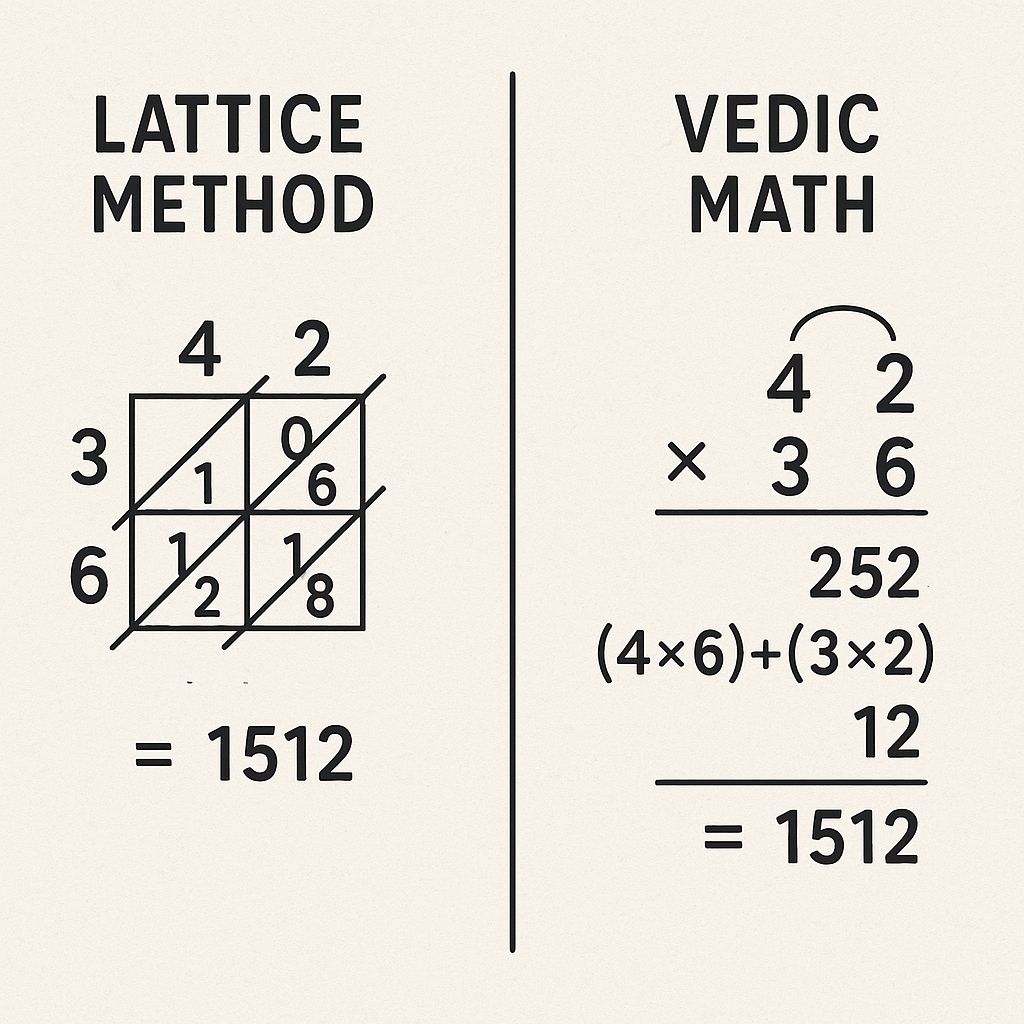Lattice Method Multiplication for Students: Definition, Simple Steps, and Examples




Struggling with long multiplication? You're not alone. The lattice method is a fun, visual way to break down big multiplication problems into smaller, easy steps. Whether you're just starting or want a cleaner process, this grid-based technique helps you stay organized and get the right answer with less confusion.

Lattice method multiplication is a visual technique that uses a grid to simplify multiplication. Instead of carrying numbers as in the traditional method, this approach places each multiplication into a separate box in a lattice, organizing partial products by diagonals. It helps reduce mistakes and supports clear thinking, especially for students learning how to multiply large numbers.
Looking for more mental math strategies? Discover the Top 5 mental math systems that make calculations easier.
Let’s learn this with a real example: 23 × 36
Create a 2×2 grid (since each number has 2 digits).
In each square, draw a diagonal from the top right corner to the bottom left.
Multiply the digits from the top and side.
Place the tens digit above the diagonal and the ones digit below.
Start from the bottom right:
Start from the top-left and follow along the diagonals: 828
23 × 36 = 828
Step | What to Do |
| Draw the lattice | Create a grid matching the digits of each number |
| Label the lattice | Write one number on top, one on the side |
| Draw diagonals | Top right to bottom left in each box |
| Multiply and fill | Fill tens above and ones below the diagonal |
| Add diagonals | Start from bottom-right; carry if needed |
| Read the answer | Follow diagonals to get the final number |

Lattice Method is a visual multiplication technique that uses a grid to break calculations into smaller parts, helping students organize and simplify large problems step by step.
Vedic Math, on the other hand, is an ancient Indian system built on 16 sutras (formulas) and 13 sub-sutras. Rediscovered by Bharati Krishna Tirthaji, it focuses on mental math, shortcuts, and fast calculation strategies, often without pen and paper.
Curious about faster math techniques? Learn more about Vedic Maths and how it helps kids calculate quickly.
Aspect | Lattice Method | Vedic Math |
| Focus | Mainly multiplication | All arithmetic + algebra, geometry, calculus |
| Style | Visual, step-by-step | Mental shortcuts using Vedic sutras |
| Mental Math | Limited | Strong emphasis on mental calculation |
| Learning Curve | Easy for beginners | Needs practice but faster once learned |
| Best For | Beginners, visual learners | Competitive exams, speed math, mental fluency |
Choose a lattice method for structured visual learning. Go for Vedic math when you want speed, mental agility, and versatility across topics.
Aspect | Lattice Method | Abacus |
| Primary Use | Multiplication | All arithmetic operations |
| Mental Math | Limited | Strong mental math via mental abacus training |
| Learning Style | Visual, grid-based | Kinesthetic + visual, progresses to mental calculation |
| Cognitive Skills | Focus on place value, error reduction | Boosts memory, motor skills, focus, creativity |

Use lattice method for clear multiplication steps. Choose abacus for mental speed and overall brain development.
Want to improve memory and math skills? Read about the Mental Abacus method and its benefits.
Vedic Maths or Abacus? Find out which one is better for mental calculations.
Aspect | Lattice Method | Trachtenberg System |
| Origin | Medieval India/China | WWII-era Europe |
| Method | Grid-based visual multiplication | Rule-based mental calculation |
| Speed | Moderate to fast | Very fast once mastered |
| Scope | Mostly multiplication | Covers all basic arithmetic |
| Learning Curve | Intuitive and easy | Requires memorization of rules |
Choose a lattice method for beginners who need structure. Use Trachtenberg for fast mental calculations and exams.
Know more about : The Trachtenberg Method: A Smart Math Shortcut Every Student Should Know
Feature | Lattice Method | Chisanbop |
| Origin | Ancient India, popularized in Europe | South Korea |
| Type | Visual and written method | Finger-based, tactile method |
| Used For | Multiplication (mainly) | Addition, subtraction, and simple multiplication |
| Tools Needed | Grid or lattice diagram | Just fingers |
| Best For | Visual learners who like organized steps | Kinesthetic learners and young children |
| Mental Math Support | Low – relies on written grids | Moderate – encourages number sense through finger use |
| Fun/Engaging Factor | Medium – can be fun to draw and follow | High – turns your hands into a calculator |
The Lattice Method is great for visual learners, while Chisanbop works well for kids who prefer hands-on learning. Choose what suits your child’s style best.
Finger math can make learning numbers fun! Check out Chisanbop, a simple and engaging finger math technique.
The lattice method of multiplication is a powerful visual tool for students who are starting to learn or struggle with multiplication. It breaks down large numbers into small, understandable steps and reduces common math errors.
While it’s not a mental math method like Vedic math or abacus, it builds strong foundational understanding.
At Interval Learning, we believe every child can learn math with the right techniques. Our non-academic Vedic math courses are designed to make learning math engaging and fun.
Explore our brain development programs for kids today!
The best method depends on your child’s learning style. Visual learners may benefit from the Lattice Method, while hands-on learners might prefer Chisanbop. Techniques from Vedic Math also help children improve speed and accuracy in mental math.
Vedic Math offers quick mental calculation techniques based on patterns and logic. While traditional mental math builds step-by-step skills, Vedic Math can make solving complex problems faster and easier.
Yes. Vedic Math complements other mental math strategies like the Lattice Method and Chisanbop. Using them together can help children strengthen their overall math understanding.
Children as young as 8–10 years old can begin learning Vedic Math and mental math techniques. Starting early helps build strong number sense and boosts confidence in solving math problems mentally.
Mental math is the ability to solve mathematical problems in your head without using paper, calculators, or other tools. It improves focus, memory, and calculation speed, and is especially helpful for day-to-day problem solving.